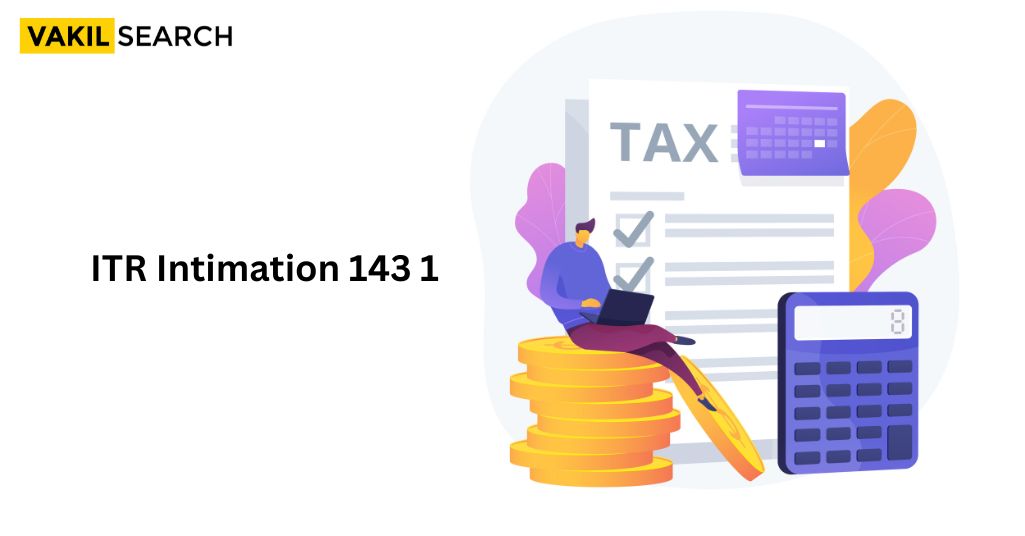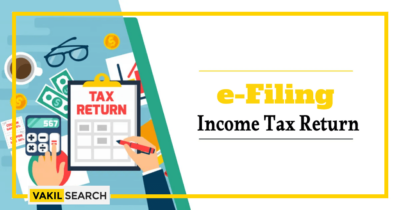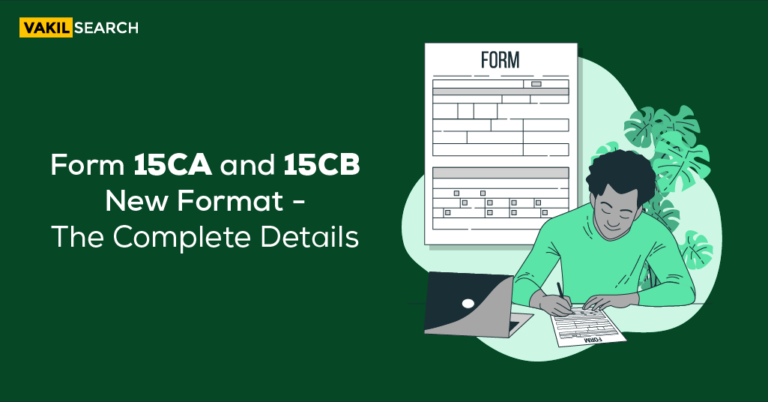This blog describes ITR Intimation 143 1 and the time of issuing an intimation.
ITR Intimation – The individuals’ income tax records first were handled online at the federal Controller Node. Following the filing of the returns, the IRS subjects an indication to the individuals under ITR Intimation 143 1, sentient them of the findings.
Notification Under ITR Intimation 143 (1) Of The Indian Penal Code
A taxable income can be submitted willingly under Section 139 or at the taxation agency’s request under Section ITR Intimation 143 1 . Knowing what occurs after a person files a federal tax return is essential.
Evaluation is the procedure by which the Tax Department examines the report filed by the individual. First, the IT department conducts a preliminary test of all submitted returns and informs taxpayers of the results. This examination concentrates on algorithmic errors, inherent contradictions, tax totaling, and yearly tax confirmation. Then, the rough estimate is computerized and entrusted to the Processor Core Center.
Following that, the system produces a warning under ITR Intimation Act, Section ITR Intimation 143 1 that generally reveals evident problems discovered by the centralized system.
After you file your income tax return (ITR), the Centralised Processing Center (CPC) will process it. They will check the information you gave. If all is okay, they send you an intimation under Section 143(1). This happens within a year from the end of the financial year in which the return is filed.
Centralised Processing Center (CPC)
The CPC is part of the Income Tax Department of India. It’s where they process all the ITRs. They check your ITR, do necessary adjustments, and send intimation. It’s all done in a fast, efficient way.
Preliminary Assessment under 143(1)
The CPC does a preliminary assessment of your ITR. This is a quick check of the details you gave. They look for mistakes or mismatches in the data. If there are no issues, they send an intimation under Section 143(1).
Sample of an intimation under 143(1)
An intimation under Section 143(1) is a notice from the Income Tax Department. It shows details of the ITR you filed and their calculations. If there’s a difference between your data and theirs, it will show. It’s a kind of final statement of your tax account for that year.
What is the Password for Intimation Under Section 143(1)?
To open the intimation under Section 143(1), you need a password. This is usually your PAN number in lowercase followed by your birth date. For example, if your PAN is ABCDE1234F and your birth date is January 1, 1990, the password will be abcde1234f01011990.
Nature of Adjustments Under 143(1)
The CPC may do adjustments to your ITR under Section 143(1). This can include:
- Correcting arithmetical errors.
- Fixing incorrect claims.
- Verifying tax credits.
After the adjustments, they send the intimation. It will show the final tax amount you need to pay or get refunded.
Stay ahead of the tax game. Calculate income tax online efficiently with our expert tool.
With the significant growth in the number of tax filings filed and an authority process style for all filings, the tax agency encountered issues resulting in tax filings being practiced late.
As a result, the Finance Act of 2008 authorized the Central Board of Direct Taxes (CBDT) to plan a method for consolidated return filing to decide the property taxes by, or the refund due to, payers more quickly. The government selected the policy that CPC in Bangalore would handle papers and e-returns with no engagement with payers and promptly, based on the proposals of the Technological Advisory Committee.
Citizens and the tax office both benefited from the CPC experiment. Citizens benefitted from quicker and easier creation of the product of their returns. At the same time, the agency was freed from a load of a preface evaluation, which could be mechanical, allowing them to focus on other essential tasks.
Taxpayers become fretful whenever they collect messages from the IRS. On the other hand, allusion under Section 143(1) is not amazing to be worried about. This post will go over the warning sent under Section ITR Intimation 143 1 to make it easier for payers to cope with such information.
The CPC’s preliminary analysis under 143(1) is computerized, and Section 143(1) Insinuation is also a desktop document. CPC compares information for each taxable income to information in the taxation agency’s internal records (like Form 26AS derived from information supplied by collection institutions, TDS reports, etc.). This warning typically only covers obvious errors revealed by the centralized system.
Learn more about E-filing of ITR
- After the report is completed, the computerized system recalculates total profits or losses based on the agency’s records and contrasts it with the information supplied by the individual.
- There are two types of insinuation: “As submitted by the applicant in the Income statement” and “As calculated under Section ITR Intimation 143 1.
- Important types are compared, including • Revenue under different heads, • Net annual revenue, • Tax breaks under Chapter VIA (80C, 80D, etc. ), and • Tax taken at origin, and also tax-funded by taxpayers in the shape of tax liabilities and identity tax.
- Things considered earnings are made as required by Section 143(1): https://www.incometaxindia.gov.in/_layouts/15/dit/pages/viewer.aspx, and a total tax burden or rebate is designed.
- The changes are completed only after the client has mentioned the transition to new, either on paper or electronically, to the email address indicated in the federal tax return.
- Any management in the form from the taxpayers within 30 days after the ITR Intimation’s issue date will be reviewed before reaching the extensive modification. The initial changes will be adopted if no answer is perceived within that time frame.
- After calculating, the ultimate tax liability is modified for TDS, tax bills, and other Sections 90/91 relief.
- A notice to the taxpayer must be drafted and mailed.
The Following Are Examples Of Probable Intimations:
- Notification with no demand or reimbursement — This usually occurs when the department accepts the report as submitted without making any changes.
- Insinuation determining request – Issued when a difference is discovered and a tax responsibility is dogged under Section ITR Intimation 143 1 .
- Insinuation establishing refund – Issued when any income is determined to be recoverable, either because there is no difference in the form submitted or after assembling changes as provided in Section 143(1) and after crediting the taxation and penalties paid by taxpayers.
What Is The Passcode For Section 143(1) Insinuation?
The ITR Intimation 143 1 notification is password-protected—your PAN (in lowercase), accompanied by your birth date in DDMMYY.
For instance, if your PAN is ADEDHBJ124E and your birthday is January 1, 2000, the passcode to access the notification will be “adedhbj1234e01012000.”
Adjustments Made Under ITR Intimation 143 1 Are Of A Different Nature (1)
After applying the following changes, total net income is determined under Section ITR Intimation 143 1:
- Any wrong claim that is obvious from any data in the returns, where an improper claim might include reading:
- A statement that contradicts another statement with the same or other items in return — for example, money from other resources is subtracted from business revenue but not stated under income from other means.
- Losses carried forward since prior years in which the report was submitted beyond the required due date are not allowed to be set off in the current fiscal year.
- Impermissibility of expenditures is noted in the audit findings but not in the tax return.
Edition Of 143 Has A Time Limit (1)
ITR Intimation under section 143(1) must be sent one year after the end of the fiscal year in which the report is submitted. For example, if a taxpayer files a return for the fiscal year 2021-22 in June 2022, the notification might be delivered until February 29, 2023. Suppose a user does not get an indication within that time frame. It simply implies that no revisions to the taxpayer’s return have been made, there has been no increase in tax obligation, and the acknowledgment filed is regarded as Section 143(1) information.
Following receipt of a 143, the taxpayer should take the following steps.
- Review some elements in Section ITR Intimation 143 1 intimation for the first stage to verify the documentation is for your refund. The data presented is for the same calendar year as stated in Section 143(1) intimation.
- Verify the following information: name, PAN, location, evaluation year for which the notification was given, and e-filing confirmation number.
- Also, if there is a tax request, enter your reply on the e-filing site, whether you agree with it.
- You could also file electronic complaints or call your evaluating inspector if you are dissatisfied with CPC’s handling of your correction return. If the CPC/assessing officer does not respond satisfactorily, you can register a complaint with the income tax tribunal.
Conclusion
Therefore, if the customer agrees to the tax department’s revenue demand after making the above changes, the taxpayer must pay all the taxes.
FAQs
What is CPC Intimation under Section 143(1)?
CPC Intimation under Section 143(1) is a notice that you get from the Centralised Processing Center (CPC) of the Income Tax Department of India. It comes after you file your income tax return. The notice tells you if the tax calculations you made match with the government's calculations.
How long does it take to get a Refund after 143(1)?
After you get the intimation under section 143(1), if it shows you should get a tax refund, it usually takes a few weeks to a few months for the money to come to your bank account. This can change based on different things, like how busy the tax department is.
How can I check my 143(1) status online?
Checking your 143(1) status online is simple. Go to the Income Tax Department's e-Filing website. Log in using your User ID, password, and captcha code. Click on 'View Returns/Forms'. Select 'Income Tax Returns' from the drop-down menu and click submit. You'll see a list of filed tax returns. Click on the 'Acknowledgement Number' of the relevant tax return to know the status.
Read More:










